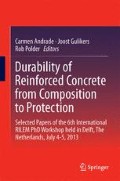Abstract
In this paper, two types of modified hydrotalcites (MHT-pAB and MHT-NO2) were incorporated into cement mortars with two dosage levels (replacing 5 and 10 % cement) and a constant water-to-(cement + MHT) ratio of 0.50. Designated testing programme including strength test, porosity test, and rapid chloride migration were employed to investigate the effect of modified hydrotalcites on chloride penetration in cement mortar. The results based on these tests revealed that the incorporation of MHT-pAB at 5 % dosage in mortar specimens produced a notably improved resistance to chloride ingress with no or minor influence on the development of mechanical strength, which further confirmed the possibilities for using modified hydrotalcite as a chloride scavenger in cement mortars.
Access this chapter
Tax calculation will be finalised at checkout
Purchases are for personal use only
References
Arya C, Xu Y (1995) Effect of cement type on chloride binding and corrosion of steel in concrete. Cem Concr Res 25(4):893–902
Bertolini L, Elsener B, Pedeferri P, Redaelli E, Polder R (2013) Corrosion of steel in concrete: prevention, diagnosis, repair. Wiley-VCH, Weinheim
Cigna R, Andrade C, Nürnberger U, Polder R, Weydert R, Seitz E (eds) (2002) COST 521: Final report, Luxembourg
Cook RA, Hover KC (1991) Experiments on the contact angle between mercury and hardened cement paste. Cem Concr Res 21(6):1165–1175
Dhir RK, El-Mohr MAK, Dyer TD (1996) Chloride binding in GGBS concrete. Cem Concr Res 26(12):1767–1773
Elsener B (2001) Corrosion Inhibitors for steel in concrete-state of the art report, vol 35, EFC publication. IOM Communications, London
Elsener B, Addari D, Coray S, Rossi A (2010) Stainless steel reinforcing bars-reason for their high pitting corrosion resistance. Mater Corros 61:1–9
EN 196–1 (2005) Methods for testing cement-part 1: determination of strength. European standard
EN 197–1 (2011) Cement-part 1: composition, specification and conformity criteria for common cements. European standard
Glass GK, Buenfeld NR (2000) The influence of chloride binding on the chloride induced corrosion risk in reinforced concrete. Corros Sci 42(2):329–344
Kayali O, Khan MSH, Ahmed MS (2012) The role of hydrotalcite in chloride binding and corrosion protection in concretes with ground granulated blast furnace slag. Cem Concr Compos 34(8):936–945
Léon Y, León CA (1998) New perspectives in mercury porosimetry. Adv Colloid Interface Sci 76–77:341–372
NT Build 492 (1999) Concrete, mortar and cement-based repair materials: chloride migration coefficient from non-steady-state migration experiments. NordTest, Espoo
Pedeferri P (1996) Cathodic protection and cathodic prevention. Constr Bldg Mater 10(5):391–402
Polder R, Hug A (2000) Penetration of chloride from de-icing salt into concrete from a 30 year old bridge. Heron 45(2):109–124
Polder R, Peelen WHA (2002) Characterisation of chloride transport and reinforcement corrosion in concrete under cyclic wetting and drying by electrical resistivity. Cem Concr Compos 24(5):427–435
Tuutti K (1982) Corrosion of steel in concrete. Swedish Foundation for Concrete Research (CBI), Stockholm
Yang Z, Shi X, Creighton AT, Peterson MM (2009) Effect of styrene-butadiene rubber latex on the chloride permeability and microstructure of Portland cement mortars. Constr Bldg Mater 23(6):2283–2290
Yang Z, Fischer H, Polder R (2014) Synthesis and characterisation of modified hydrotalcites and their ion exchange characteristics in chloride-rich simulated concrete pore solution. Cem Concr Compos 47:87–93
Yang Z, Fischer H, Cerezo J, Mol JMC, Polder R (2013a) Aminobenzoate modified Mg-Al hydrotalcites as a novel smart additive of reinforced concrete for anticorrosion applications. Constr Bldg Mater 47:1436–1443
Yang Z, Fischer H, Polder R (2013b) Modified hydrotalcites as a new emerging class of smart additive of reinforced concrete for anti-corrosion applications: a literature review. Mater Corros 64(12):1066–1074
Acknowledgements
The research was carried out under the project number M81.609337 in the framework of the Research Program of the Materials innovation institute (M2i) (www.m2i.nl). Sasol Germany GmbH is acknowledged for the gift of hydrotalcite that was used in this research.
Author information
Authors and Affiliations
Corresponding author
Editor information
Editors and Affiliations
Rights and permissions
Copyright information
© 2015 Springer International Publishing Switzerland
About this chapter
Cite this chapter
Yang, Z., Fischer, H., Polder, R. (2015). Effect on Mechanical Properties and Chloride Penetration Resistance of Modified Hydrotalcite in Cement Mortar. In: Andrade, C., Gulikers, J., Polder, R. (eds) Durability of Reinforced Concrete from Composition to Protection. Springer, Cham. https://doi.org/10.1007/978-3-319-09921-7_11
Download citation
DOI: https://doi.org/10.1007/978-3-319-09921-7_11
Published:
Publisher Name: Springer, Cham
Print ISBN: 978-3-319-09920-0
Online ISBN: 978-3-319-09921-7
eBook Packages: EngineeringEngineering (R0)

